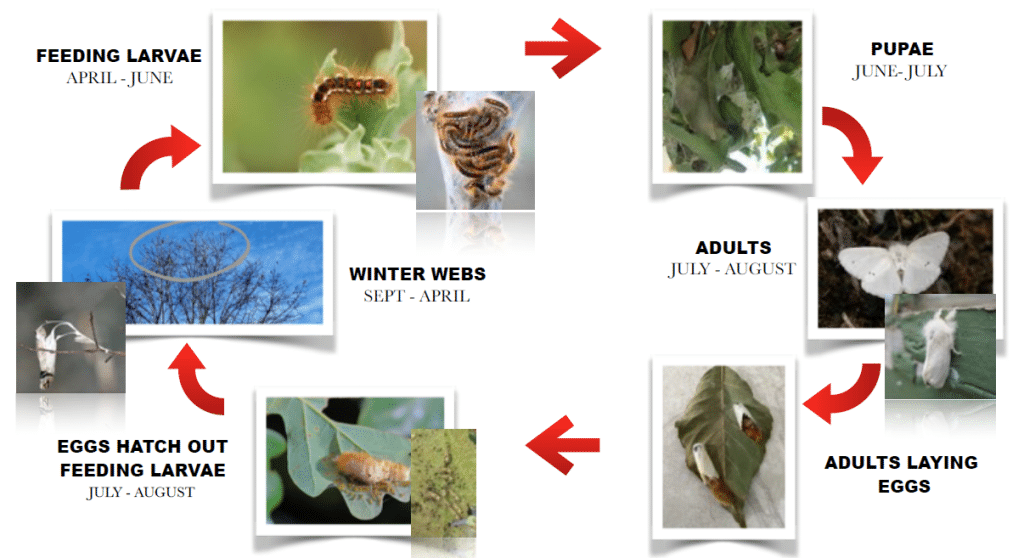Maine Browntail Moth
Browntail Moth caterpillars, common throughout Midcoast Maine, are 1 to 1.5 inches long with broken white stripes along their sides and two distinct orange spots on their back. These hairy caterpillars pose a health risk—their toxic hairs can cause a severe, poison ivy–like rash and respiratory irritation in people and pets.
As folivores, Browntail Moth caterpillars feed on the leaves of oak, birch, and fruit trees, causing significant defoliation across the region. Treatment options depend on the pest’s life stage, which follows a full metamorphosis: egg, larva, pupa, and adult. At Hawkes Tree Service, we tailor our Browntail Moth control strategies to the seasonal activity of the moth to ensure the most effective results.
Learn more about treatment timing and life stages in the cycle below.

Life cycle better explained
Browntail Moth larvae (caterpillars) emerge from winter webs in trees from April to May and begin actively feeding on the new leaf tissue. They feed continuously until they are fully grown in June. The larvae then begin to move towards areas where they can pupate (cocoon stage). They can typically be seen on houses, lower branches of trees and other protected areas at this point while they are transitioning into moths. Later in June and early July the white moths will emerge, mate and lay eggs on the underside of leaves of new host trees. The young larvae will emerge in mid-August and begin feeding on the leaves of the host tree. In late September, the young larvae will begin making communal winter webs they will over-winter in. The larvae produce a white silk that they use to coat the outside of their webs that protects them from snow and rain and firmly anchors them to tree branches. These communal winter webs can have up to 600 larvae each.
When Should Browntail Moth Treatments Be Done?
In Midcoast Maine, manual removal of Browntail Moth winter webs is most effective from October through early April—before the caterpillars begin to emerge. Chemical treatments, including foliar sprays and trunk or soil injections, are typically applied twice per year: in the spring and fall when the larvae are actively feeding. For best results, treatment timing should align with key stages in the Browntail Moth life cycle (see chart below).
What Trees Do Browntail Moth Caterpillars Feed On?
Browntail Moth caterpillars primarily feed on oak, apple, crabapple, pear, birch, and cherry trees, but they can also damage a wide variety of other deciduous trees common throughout Maine. Their feeding can cause significant defoliation, weakening trees and increasing their vulnerability to other pests and diseases.
Browntail Moth Treatment Methods: Pruning, Injections & Sprays
At Hawkes Tree Service, we specialize in Integrated Pest Management (IPM) to provide effective Browntail Moth control across Maine. Our process begins with a thorough property assessment and accurate identification of Browntail Moth infestations. We then implement a customized treatment plan utilizing a combination of biological, cultural, physical, and chemical methods to minimize environmental impact while effectively managing the pest population.
Our licensed professionals conduct detailed site inspections to identify Browntail Moth nests and caterpillars, developing tailored treatment plans to protect your trees’ health and value. Our comprehensive treatment options include manual pruning of winter webs, systemic trunk and soil injections, basal bark applications, hand-held spraying, and high-powered foliar spraying. Depending on the severity of the infestation, we may recommend a single method or a combination to ensure effective control.
Browntail Moth nests and caterpillars can be difficult to spot in many Maine trees—especially during the winter and early spring months. Our licensed pest control experts can help identify and assess threats to your property, ensuring timely and effective treatment options.
Maine Browntail Moth Control Regulations & Guidelines
The State of Maine has strict guidelines for which products and treatment methods may be used for Winter Moth within 250 feet of the mean high water mark. These laws are designed to protect the integrity of marine ecosystems and habitats. Inside this setback zone we recommend individual tree injections. Soil injections use a small volume of product inserted near the base of the tree’s root flares where the fibrous root hairs can absorb it. The systemic product is translocated throughout the tree with other nutrients and delivered to the new tissue in growing leaves.
Trunk injections work in a similar way and use a systemic product as well. In this case, we actually drill a small hole into the root flares of the tree and insert a needle that is connected to a system containing our product. The tree will pull the product in as it does with water and other nutrients and when we are done the tree will compartmentalize the small wounds and quickly heal over.
Every property is a bit different when it comes to treatment methods for Winter Moth. If you would like more information or a free consultation for your property, please contact us or call today at (207) 442-7444.

